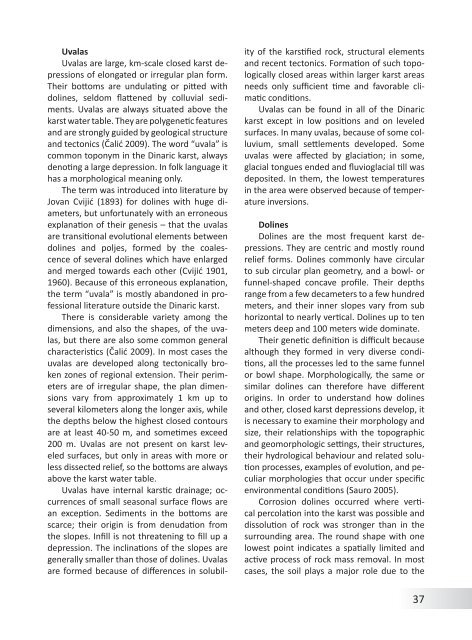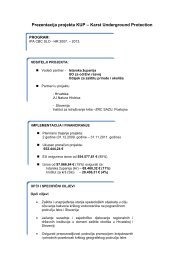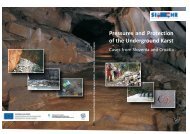Case Studies from the Dinaric Karst of Slovenia
Case Studies from the Dinaric Karst of Slovenia
Case Studies from the Dinaric Karst of Slovenia
Create successful ePaper yourself
Turn your PDF publications into a flip-book with our unique Google optimized e-Paper software.
UvalasUvalas are large, km-scale closed karst depressions<strong>of</strong> elongated or irregular plan form.Their bottoms are undulating or pitted withdolines, seldom flattened by colluvial sediments.Uvalas are always situated above <strong>the</strong>karst water table. They are polygenetic featuresand are strongly guided by geological structureand tectonics (Čalić 2009). The word “uvala” iscommon toponym in <strong>the</strong> <strong>Dinaric</strong> karst, alwaysdenoting a large depression. In folk language ithas a morphological meaning only.The term was introduced into literature byJovan Cvijić (1893) for dolines with huge diameters,but unfortunately with an erroneousexplanation <strong>of</strong> <strong>the</strong>ir genesis – that <strong>the</strong> uvalasare transitional evolutional elements betweendolines and poljes, formed by <strong>the</strong> coalescence<strong>of</strong> several dolines which have enlargedand merged towards each o<strong>the</strong>r (Cvijić 1901,1960). Because <strong>of</strong> this erroneous explanation,<strong>the</strong> term “uvala” is mostly abandoned in pr<strong>of</strong>essionalliterature outside <strong>the</strong> <strong>Dinaric</strong> karst.There is considerable variety among <strong>the</strong>dimensions, and also <strong>the</strong> shapes, <strong>of</strong> <strong>the</strong> uvalas,but <strong>the</strong>re are also some common generalcharacteristics (Čalić 2009). In most cases <strong>the</strong>uvalas are developed along tectonically brokenzones <strong>of</strong> regional extension. Their perimetersare <strong>of</strong> irregular shape, <strong>the</strong> plan dimensionsvary <strong>from</strong> approximately 1 km up toseveral kilometers along <strong>the</strong> longer axis, while<strong>the</strong> depths below <strong>the</strong> highest closed contoursare at least 40-50 m, and sometimes exceed200 m. Uvalas are not present on karst leveledsurfaces, but only in areas with more orless dissected relief, so <strong>the</strong> bottoms are alwaysabove <strong>the</strong> karst water table.Uvalas have internal karstic drainage; occurrences<strong>of</strong> small seasonal surface flows arean exception. Sediments in <strong>the</strong> bottoms arescarce; <strong>the</strong>ir origin is <strong>from</strong> denudation <strong>from</strong><strong>the</strong> slopes. Infill is not threatening to fill up adepression. The inclinations <strong>of</strong> <strong>the</strong> slopes aregenerally smaller than those <strong>of</strong> dolines. Uvalasare formed because <strong>of</strong> differences in solubility<strong>of</strong> <strong>the</strong> karstified rock, structural elementsand recent tectonics. Formation <strong>of</strong> such topologicallyclosed areas within larger karst areasneeds only sufficient time and favorable climaticconditions.Uvalas can be found in all <strong>of</strong> <strong>the</strong> <strong>Dinaric</strong>karst except in low positions and on leveledsurfaces. In many uvalas, because <strong>of</strong> some colluvium,small settlements developed. Someuvalas were affected by glaciation; in some,glacial tongues ended and fluvioglacial till wasdeposited. In <strong>the</strong>m, <strong>the</strong> lowest temperaturesin <strong>the</strong> area were observed because <strong>of</strong> temperatureinversions.DolinesDolines are <strong>the</strong> most frequent karst depressions.They are centric and mostly roundrelief forms. Dolines commonly have circularto sub circular plan geometry, and a bowl- orfunnel-shaped concave pr<strong>of</strong>ile. Their depthsrange <strong>from</strong> a few decameters to a few hundredmeters, and <strong>the</strong>ir inner slopes vary <strong>from</strong> subhorizontal to nearly vertical. Dolines up to tenmeters deep and 100 meters wide dominate.Their genetic definition is difficult becausealthough <strong>the</strong>y formed in very diverse conditions,all <strong>the</strong> processes led to <strong>the</strong> same funnelor bowl shape. Morphologically, <strong>the</strong> same orsimilar dolines can <strong>the</strong>refore have differentorigins. In order to understand how dolinesand o<strong>the</strong>r, closed karst depressions develop, itis necessary to examine <strong>the</strong>ir morphology andsize, <strong>the</strong>ir relationships with <strong>the</strong> topographicand geomorphologic settings, <strong>the</strong>ir structures,<strong>the</strong>ir hydrological behaviour and related solutionprocesses, examples <strong>of</strong> evolution, and peculiarmorphologies that occur under specificenvironmental conditions (Sauro 2005).Corrosion dolines occurred where verticalpercolation into <strong>the</strong> karst was possible anddissolution <strong>of</strong> rock was stronger than in <strong>the</strong>surrounding area. The round shape with onelowest point indicates a spatially limited andactive process <strong>of</strong> rock mass removal. In mostcases, <strong>the</strong> soil plays a major role due to <strong>the</strong>37










